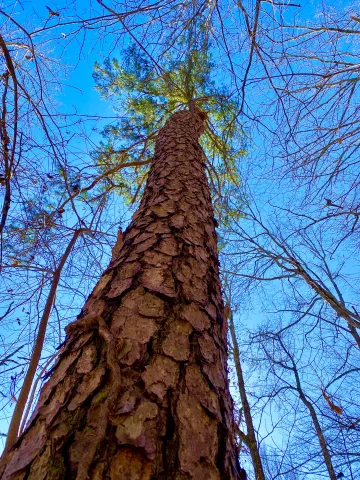Trees and Lightning

By: Steve Roark
Volunteer, Cumberland Gap National Historical Park
Everyone is aware of the safety tip of not standing under a tree during a thunderstorm, based on the likelihood that the tallest objects are most likely to be struck by lightning. But there’s more to being struck than just being tall.
Studies indicate that certain trees are zapped by lightning more than others. Oaks are by far the most likely trees to be hit, and I support that with personal observations. Whenever I see a tree damaged by lightening, most of the time it's an oak. Other trees that seem to be common targets include elm, ash, yellow poplar, and pine. The least likely tree species to be struck include beech, birch, holly, and maples. It may only be coincidental, but smooth barked trees are struck less often rough barked ones.
Why a certain tree is prone to lightning strike seems to be a matter of how good of a conductor of electricity it is. Those that have a central taproot extending into groundwater are more likely to be hit than trees with shallow roots. Trees that are tall, growing in the open, bordering woods or along a stream have higher odds to being struck.
How much damage lightning inflicts varies from none to blowing the top out of the tree. It often runs a streak of blown off bark down the tree trunk. Trees are damaged far worse if they are struck before it rains. If hit after rain begins, the water wetting the bark can provide a conductive surface for electricity and prevent the interior of the tree from being damaged.
Hundreds of lightning fatalities occur each year, so thunderstorms should be taken seriously when they pop up rapidly during the hot summer months. Here are some safety rules: Seek shelter indoors when a storm builds up. Picnic shelters, tents and covered porches don’t count. The high winds and dark skies prior to a storm will give you ample warning to find some cover. Keep in mind that lightning can occur well beyond the area of heavy rain. The rule of thumb is that if you can hear thunder, you’re within the strike zone. Don't bathe or shower during a storm, and don't use a corded phone.
If driving in a car during a storm, stay in it. The metal exterior will prevent lightning from getting inside the car. If a bad storm catches you away from shelter, lie prone on the ground near a ditch or embankment. Try to avoid areas with tall trees. Swimmers and boaters should get out of the water as soon as they see a storm coming. Being on the water during thunderstorms is very dangerous.
- Log in to post comments